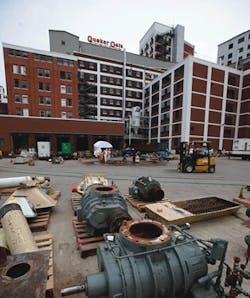Flood of 2008: Quaker Oats
On Friday, June 13, when the Cedar River crested at 31 feet, it exceeded its banks to become nearly 2 miles wide. It then spilled over the dike and sandbags, and filled the basements of the 22 buildings on the site of the Quaker Oats plant in Cedar Rapids. "We became part of the river," says Don Chizek, Cedar Rapids plant manager, Quaker Oats.
The days and minutes before water overtook the plant were spent acting on a plant-protection plan that Chizek and the rest of the 1,100 employees at the site were counting on to minimize damage. A group of senior leaders were called together on Monday, June 9, and the written plans quickly became a list of instructions. Because the plant is located along the Cedar River's banks, and the company knew that flooding was likely, strategies to lessen damage had been applied to protect the facilities: A dike had been built, floodwater pumps had been installed, and a berm had been added as a natural wall to keep rising waters out. No one at the time could have predicted just how helpful these changes would be.
Proactive Measures
As the week of June 9 progressed, predictions of the river's crest rose, along with concerns that existing measures might not be enough to protect the plant from flooding. Temporary pumps that could pump water out of the parking lot and back over the dike were added. To shore up the berm in low spots, a local construction company was called. A steady stream of dump trucks carrying quarry-bottom clay flowed into the site. "We were pretty well protected [if the river rose to 24 feet]. As we were seeing that it was going to get higher than originally anticipated, we enacted a robust process of putting a berm inside the existing berm, shoring it up, strengthening it, and raising it a little bit higher, knowing that we were going to see a higher flood [level]," explains Chizek. Sandbagging the berm would have proved too ambitious given the time and effort necessary; with more than 1,000 truckloads of clay, the berm was secured.
Despite all of the efforts to prevent the river from overflowing its banks into the plant, floodwaters actually began creeping toward the plant from the street. "Our parking lot was filling up from the storm sewer system prior to it filling up from the river coming over the berm," Chizek says. In the early morning hours on Thursday, June 12, water started coming over the dike.
Mitigating the Damage
With water encroaching onto the site's 25 acres of land, efforts quickly mobilized indoors. Vital infrastructure was moved, along with records, computers, and equipment. As the situation escalated, the site was totally evacuated. "That's kind of a historical event," Chizek says about the plant's absence of maintenance and security personnel. "In anybody's recollection, that's never happened before."
A crisis command center was set up in a hotel in northeast Cedar Rapids; plans to clean and reoccupy the plant's facilities, as well as repair and replace damaged equipment, were created and executed. With steam and gas lines, and electrical conduits located in the site's submerged basements, and 30 to 36 inches of water on the buildings' first floors, the undertaking would be massive. Eleven teams were formed to address everything from cleaning to structural integrity and materials recovery. Without access to the site for 4 days, these teams carefully devised a way to "get the old gal back up on her feet," explains Chizek. By the time the plant was accessible again, so many contractors had been scheduled to arrive that traffic jams were a daily occurrence around the site.
Just 3 weeks after the flood, the plant was up and running with limited operations. By mid August, full operations had resumed. As a testament to how well the company's plant protection and mitigation plans worked, Chizek says, "Frankly, there are a lot of things I'd do again in a crisis like this."
More Flood Stories:
-
Mercy Medical Center - By Jana J. Madsen
-
Alliant Energy Tower - By Jenna M. Aker
-
The University of Iowa - By Leah B. Garris
-
City of Cedar Rapids - By Jenna M. Aker
-
Guaranty Bank & Trust - By Linda K. Monroe
-
Quaker Oats - By Jana J. Madsen
-
Cedar River Tower - By Linda K. Monroe
Jana J. Madsen ([email protected]) is editor at Buildings magazine.


